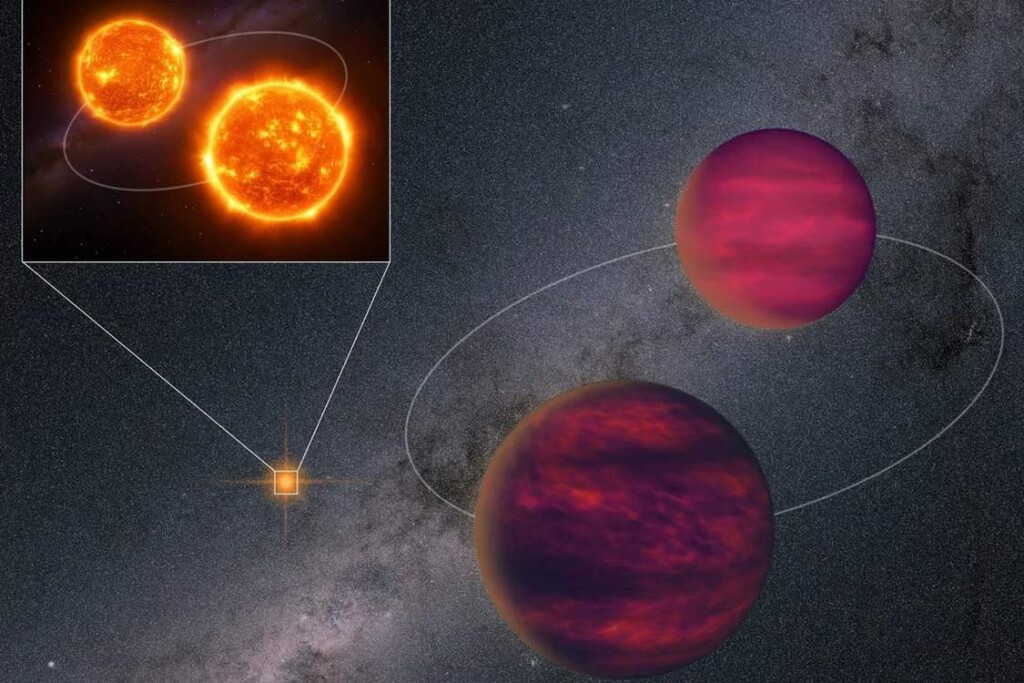The Wild Quadruple Star System Contains Not One, But Two Of The Most Illusive Objects In The Galaxy

An international team of astronomers recently found not one, but two of the strangest and rarest of all cosmic objects, and in the same star system no less.
Called brown dwarfs, these peculiar objects are invaluable resources for learning about the formation of stars, planets, and systems.
These would-be stars fail to accumulate enough mass and heat to perform continuous nuclear fusion of hydrogen molecules, and so slowly cool and harden as the years go by until they look and feel more like a planet than a star.
Being thusly cold but also small, they’re really hard to find with even a sophisticated telescope, so imagine the astronomers’ surprise when they found not one, but two—orbiting not one, but two stars.
Called a “double-double” by one member of the team, representing universities and institutes from the US, China, UK, and Spain, the cosmic quartet will provide a “unique cosmic laboratory for studying these mysterious objects.”
The system’s designation is a mouthful: UPM J1040−3551 AabBab. It’s located 1,656 astronomical units away from Earth, and the brown dwarves are estimated to be between 9 and 28-times the mass of Jupiter They’re both orbiting a much more familiar kind of dwarf: red dwarf stars.
One of the most common star types in the universe and also the smallest, the red dwarves are between 300 million and 2 billion years old, Smithsonian wrote, reporting on the discovery. This makes them relatively young, and therefore more interesting to study as the secrets of their origin are more likely to be detectable.
Though the astronomers didn’t present a hypothesis as to why there are two half-star, half-planets in the system, one might guess it’s because there wasn’t enough material for them to fully form—it was being devoured to create the two red dwarves; each of which formed into the smallest star type because material was being absorbed to form the brown dwarves.
In short, there were too many pieces of too small a pie.
An article from NASA in the year 2000 cited by Smithsonian somewhat supports the hypothesis. At the time, the Hubble Space Telescope had just completed the largest inventory of brown dwarves in the Milky Way ever undertaken, and the agency claimed the average size was in fact between 15 and 80-times the size of Jupiter.
MORE STELLAR SURPRISES: LOOK at All the Dark Matter in This New Image from the James Webb Telescope
Those in UPM J1040−3551 AabBab are a fraction of that size, suggesting there wasn’t enough material to go around to make even large brown dwarves, much less larger stars.
The discovery was made using the European Space Agency’s Gaia telescope, and NASA’s Wide-field Infrared Survey Explorer (WISE), with the help of the Southern Astrophysical Research (SOAR) telescope in Chile.
MORE STELLAR SURPRISES: Astronomers Spot Interstellar Visitor: a Comet Blazing Through Our Solar System, Just the Third Ever Seen
“This system offers a dual benefit for brown dwarf science,” Adam Burgasser, an astrophysicist at the University of California San Diego, and a member of the research team, said in a statement.
“It can serve as an age benchmark to calibrate low-temperature atmosphere models and as a mass benchmark to test evolutionary models, if we can resolve the brown dwarf binary and track its orbit.”






Please be good and do not spam. Thank you.